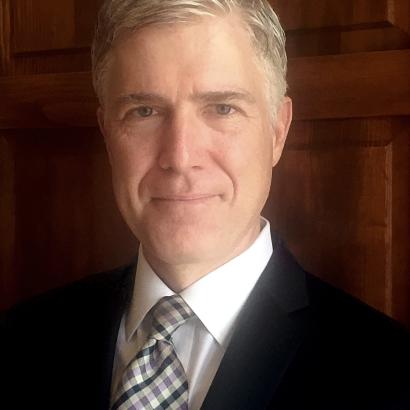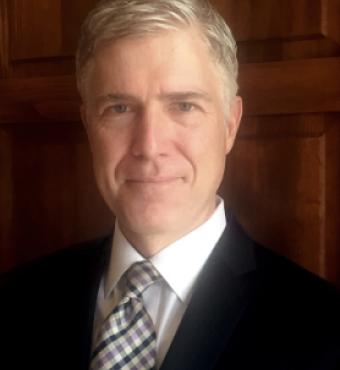It does not take a weatherman to tell which way the wind is blowing on Neil Gorsuch’s Supreme Court nomination. Gorsuch will be confirmed, one way or another. If Senator Charles Schumer makes good on his pledge to filibuster the Gorsuch nomination, the Republicans will exercise their so-called nuclear option to end the filibuster rule for Supreme Court nominees, after which Gorsuch’s nomination will be confirmed, perhaps on a strict party-line vote of 52-to-48 Senators. The Democrats cannot get over the fact that the Republicans did not need to filibuster to stonewall Merrick Garland, given their majority in the Senate. They could just sit on his nomination. But since the Democrats could not stop the hearings for Gorsuch, they have chosen to act out their unhappiness by raising frivolous objections against an exceptionally well-qualified nominee who enjoys the respect of everyone who has worked with him.
This increased polarization of the Senate is a relatively recent phenomenon. Between 1954 and 2005, a large number of liberal justices were appointed by Republican Presidents. The list includes Chief Justice Earl Warren, and Justices William Brennan, John Paul Stevens, Harry Blackmun, and David Souter. But the divisions have hardened since then. The last six choices to the Court—Justices Ruth Ginsburg, Stephen Breyer, John Roberts, Samuel Alito, Elena Kagan and Sonia Sotomayor—have not made any surprise judicial conversions. But Schumer was correct in noting that all six of these nominees overcame the filibuster hurdle by garnering 60 votes—a fact he is using to attack Gorsuch with: “If this nominee cannot earn 60 votes—a bar met by each of President Obama’s nominees and George Bush’s last two nominees—the answer isn’t to change the rules. It’s to change the nominee.” In fact, the Democrats could still take the same approach they used with Samuel Alito in 2005: avoid the filibuster by a 72-25 vote (Obama and Schumer among the 25) and then allow confirmation to take place by a 58-42 vote, including some Democratic senators.
Instead, Schumer wants to bait Gorsuch, as Orrin Hatch has lamented. Schumer knows full well that Gorsuch has said that he will rule independently of the President’s preferences—be it Donald Trump or his successors. So why not believe him? Instead, Schumer asks for the impossible—he wants Gorsuch to endorse liberal views before being confirmed. After all, in his view, the reason that Gorsuch refuses to do so is that his “career and judicial record suggest not a neutral legal mind but one with a deep-seated conservative ideology.” The voting record of any appellate judge is an imperfect predictor of his behavior on the Supreme Court. But in any event, the phrase “neutral legal mind” applies far more accurately to Gorsuch, as former Tenth Circuit judge Michael McConnell has shown, than it does to die-hard progressives like Schumer, who think about every issue in partisan terms. Gorsuch is also keenly aware that the law is not a world of happy endings, in which the clever judge can always get his preferred moral outcome by a manipulation of the rules of statutory construction. Bad laws, he knows, often lead to unfortunate results. “A judge who likes every result he reaches,” he has written, “is very likely a bad judge, reaching for results he prefers rather than those the law compels.”
Indeed, it is wholly inappropriate for Schumer or anyone else to ask Gorsuch to swear allegiance to a list of Democratic causes such as reproductive rights. As an initial matter, every critic of Gorsuch should recognize the strong reality that their own substantive views are not beyond criticism. Gorsuch’s critics would do well to have, about their own positions, a fraction of his instinctive humility. Besides, they should put their fears to rest, because it’s unlikely that Gorsuch will be a loose cannon on the Court. By temperament, he is a conciliator not a rebel, and in general he respects long-standing precedents even when the grounds for the original decision are dubious. For example, the Court’s 2016 decision striking down various Texas restrictions on access to abortions in Whole Woman’s Health v. Hellerstedt, was in my view correct—so long as Roe v. Wade is on the books. Indeed, that case turned on a theme that both conservatives and progressives should accept, namely, that purported health and safety regulations are often pretexts for shutting down the underlying activity, whether it be abortion clinics or nonunion shops.
I would think that Gorsuch could easily hold that view as well, given his ability to decide cases within the current framework of the law, even if he might disagree with its first principles. As his own testimony confirms, he will not be the type of justice to mount an assault on Roe v. Wade, notwithstanding its shaky constitutional foundations, now that it has been law for the past 44 years. “Part of being a good judge is coming in and taking precedent as it stands,” he said, “and your personal views about precedent have absolutely nothing to do with the job of a good judge.”
During the last day of hearings, some Senators raised questions about how Gorsuch would approach the key question of Chevron deference, under which the courts follow administrative interpretations of the agencies’ own statutes unless the text is clearly to the contrary. Gorsuch was also asked about the doctrine of standing, which limits the right of at least some parties to challenge government regulations in court. On both fronts, Gorsuch responded in a very reasonable manner.
Let’s look at administrative deference first. When it seemed likely that Hillary Clinton would be elected as President of the United States, it was possible for progressives to celebrate executive power by praising what Harvard Professor Cass R. Sunstein called “The Most Knowledgeable Branch.” Now that Trump is President, the left has grown wary of executive overreach, especially in the wake of Trump’s first executive order on immigration. But the need for judicial oversight of administration action is neither a conservative nor a progressive cause. All political actors have axes to grind, and this tendency is especially strong among administrators whose portfolio covers only a single set of issues, like labor or environment, on which it is easy for them to form strong points of view. Interpreting legal texts is the quintessential function of appellate judges, and one that was explicitly reserved to them under Section 706 of the Administrative Procedure Act of 1946. If agency officials have any added expertise on the topics within their jurisdiction, they should be able to persuade judges of the soundness of their substantive views. But all too often, their interpretations are driven by powerful political agendas that can flip quickly from one administration to the next. It is these swings that judges should curb. Judges make these interpretive calls all the time on complex statutes when no administrative officials are involved. They can do the same even if they are present.
Judge Gorsuch has already indicated his unhappiness with Chevron deference as “a judge-made doctrine for the abdication of the judicial duty.” That view sets him in opposition to the late Justice Scalia, who accepted judicial deference to administrative interpretations even on jurisdictional matters, notwithstanding the obvious danger that agencies will extend their powers outside the proper scope of their legislative mandate. Gorsuch has taken heat from his Democratic opponents who think that broad administrative discretion is necessary because Congress cannot anticipate every situation to which a legal rule can apply. But the two propositions are not inconsistent. Surely on matters of fact, agencies, like juries, have a certain degree of discretion. There is no more reason for courts to defer to administrative agencies on questions of law than to defer to juries. On questions of law, agencies have no comparative advantage over judges. With the change in the political guard, people like Schumer should welcome Gorsuch’s view as a restraint on the Trump administration, and hope that, once confirmed, he will help wean the law away from Chevron.
The same approach should apply to standing doctrine, on which it is harder to read Gorsuch. The doctrine was defended by Justice Scalia on supposed originalist grounds, as a necessary consequence of the principle of separation of powers. On that point, he was almost surely wrong. Standing—e.g. the right to bring suit—is not a peculiar feature of the United States Constitution. It is a doctrine that, as its Latin origin locus standi indicates, is an inherent limitation on the power of all courts to decide any and all cases brought before them. As a textual matter, the term “standing” appears nowhere in the Constitution, so that its explication is a matter of general principle, which must take into account that the specific language of Article III, Section 2 provides, without special limitation, that the “judicial power shall extend to all cases, in law and equity.”
Those last two words are critical because, even if cases in law usually award damages only to parties who suffer particular injuries, the Court’s equitable jurisdiction has included, from the time of the Founding period, the power to enforce the ability of any shareholder or ratepayer to enjoin actions that were outside the scope of an actor’s private or public charter. As many environmental groups have rightly testified, access to the courts is needed to make sure that administrative agencies remain within the scope of their statutory authority, and Congress within the scope of its constitutional powers. Justice Gorsuch might well deviate from Justice Scalia on this vital point, in a way that would consistently enforce the rule of law against government officials of both parties. It is a sign of Schumer’s intellectual blindness and political short-sightedness that he chooses to attack an intellectually gifted judge with superb credentials whose own decisions might actually dovetail with some of the Senator’s own substantive views.
















